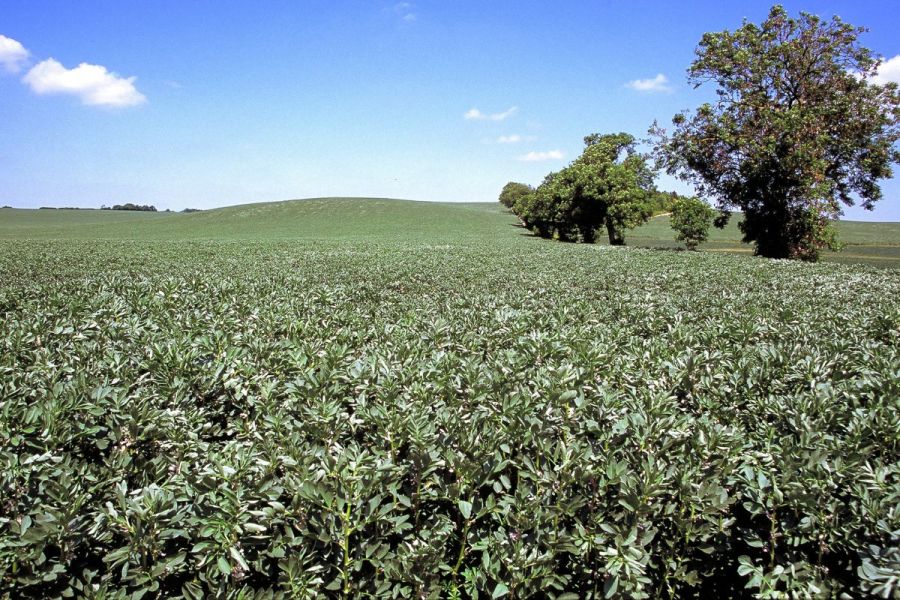By identifying key stress points and applying appropriate interventions at the correct time, UK farmers could have the opportunity to improve the consistency and profitability of home-grown protein crops. CPM explores some of the products which promise to up the ante when it comes to pulses.
“With pulses, they have to perform in their own right, but it’s the bigger picture benefits which really stack up.” – RUSSELL MCKENZIE
By Janine Adamson
The benefits of growing pulses as part of an arable rotation are well documented – from improving soil health and delivering nitrogen fixation to re-balancing farm workloads and boosting the potential of the following crop – and that’s before considering wider gains such as reducing the UK’s reliance on imported protein sources.
However, it’s inconsistency of yields which has so far hampered their potential, believes NPZ’s Michael Shuldham. “During recent years, pulses haven’t necessarily met expectations yield-wise, and this can mostly be attributed to challenging, dry conditions during the spring months.
“But based on the significance of their benefits – particularly an ability to replace imported soya – pulses should be among the UK’s most important crops and top of the tree. Therefore it’s vital that the industry comes together to identify ways to optimise the critical establishment phase, enabling plants to push roots down and overcome potential high stress periods,” he says.
ROTATION STAPLE
With a shift away from oilseed rape due to the perceived risks associated with the crop, Cambridgeshire grower, Russell McKenzie, says despite the lure of environmental schemes, pulses have a firm place in his farm’s rotation.
“This year is the first time we’ve not grown OSR in my entire farming career, but conversely, we’ve always tended to make pulses work. Previous to the recent announcement, SFI would have been the absolute last option.
“With pulses, yes they have to perform in their own right, but it’s the bigger picture benefits which really stack up. For example, a wheat crop after a pulse always yields superbly whereas the legacy pitfalls post-SFI aren’t worth it, in my opinion,” he explains.
Having experienced crop inconsistency first-hand, particularly when it came to pod set in winter beans, Russell says he wanted to investigate whether a biostimulant could be the answer. “The crop would pod up but on closer inspection, they’d actually be blind.
“So we decided to use two applications of Unium’s Calfite Extra (calcium phosphite+ L-PGA) – one early in the season and one pre-flowering – to see if we could achieve a better pod set. It seems that by going early and kick-starting growth including rooting, the result has been more consistency in the crop.”
To investigate this more formally, Russell conducted an on-farm winter bean trial comparing an early application of Calfite Extra versus untreated (all otherwise received the farm-standard input programme). “Harvest results indicate we achieved a yield uplift of 0.7t/ha by using Calfite Extra.
“Beans are relatively low input, but Calfite Extra is a cost-effective product which means what we are spending is being targeted effectively and delivering results,” he adds.
To explain why Calfite Extra is having such a positive effect in pulses, Unium’s Andrew Cromie says it’s down to how the product improves crop rooting. “It’s a foliar-applied stimulant which essentially tricks a plant into scavenging for nutrients and therefore boost its roots and exudates.”
Having already successfully tried another Unium product in his cereal crops – 3ALO T6P – Russell now plans to utilise this in winter beans too. “This would be at the later timing of during or just after flowering, to help overcome any potential abiotic stress,” he says. “We know it works well at T3 in winter wheat, it’s just understanding how to replicate that performance in beans.”
Russell isn’t alone in using biostimulants to improve the performance of his pulses – data produced by Kynetec’s National Farm Research Unit (via LOCUS market information system) suggests that in 2023, more than 85% of growers were either using or considering using biostimulants on legume crops. In 2022, this figure was around 62%.
A grower well-versed in the benefits of using biostimulants across all crops is Bedfordshire-based Matt Fuller from 1000ha Heathcote Farms, who says the main reason he uses them in pulses is to overcome plant stress events. Like Russell, he’s also been conducting on-farm trials using Unium products.
“Pulses have become an important part of our rotation, mainly as an entry crop ahead of milling wheat to help improve its yield and quality.
“But looking at how to boost the profitability of the pulse crop itself led us to trial alternative sources of nitrogen in winter beans. We’ve been investigating two foliar products based on endophytic bacteria – one of which is Unium’s Tarbis – compared with untreated,” he explains.
The trials are now in their third season of replication, although Matt highlights that last year’s challenging conditions may have influenced 2024’s results somewhat. “Last season, although very wet, was a positive year for beans overall – there wasn’t as much stress in the crop as you’d usually expect if there’d been a dry spring, which is why you’d want to be using these products.”
YIELD UPLIFT
Even so, averaging the data for the two harvest years so far (2023 and 2024) indicates Tarbis delivers a yield of 5.48t/ ha compared with 4.55t/ha for untreated. “I anticipate that in a more usual year for beans, you’d see an even greater uplift from using Tarbis,” suggests Matt.
Andrew adds that similar to Unium’s endophytic seed treatment, Tarbis combines endophyte strains which enable crops to fix nitrogen, sequester phosphorous, potassium and zinc, and better withstand drought, making it an ideal solution for high-stress conditions.
“By improving nutrient use efficiency you can create a more robust pulse crop which can handle abiotic stress better, resulting in the yield uplifts as seen at Heathcote Farms,” notes Andrew.
Matt has also been exploring 3ALO T6P across all crops, observing particularly positive results in peas when used alongside Unium’s Kirol PGA (amino acids+ pidolic acid). In fact, an application of 3ALO T6P plus Kirol PGA in combining peas delivered around +2.5t/ ha yield uplift compared with untreated.
“An added benefit of 3ALO T6P is it’s quite flexible in its application for when weather conditions are stretching spray timings. It also has a good tank mix profile which is essential when you’re limited to when you can travel,” he says.
“Ultimately, we want to make pulses work because without them, we’re left with OSR, oats or SFI [dependent on the government’s recent announcement] as our break crops, which all come with their own distinct management challenges. Biostimulants are helping us to not only achieve better pulse crop establishment, but also keep plants greener for longer which translates through to performance.
“You lose most yield potential in pulses during high stress, droughty conditions. As long as we can make money growing conventional break crops, then that’s the approach we’ll continue to take,” he concludes.
This article was taken from the latest issue of CPM. Read the article in full here.
For more articles like this, subscribe here.
Sign up for Crop Production Magazine’s FREE e-newsletter here.




